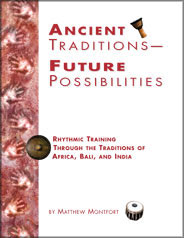World Rhythms in the Classroom

Kentfield: Ancient Future Music, 1985. ISBN 0-937879-00-2.
Comb Bound Book- $46.95 (SALE $33.95):
Add Book to Cart. Buy Book Now.
Companion Enhanced Audio CD- $39.95 (SALE $28.95):
Book/Enhanced Audio CD Set- $74.95 (SALE $53.95):
Add Book/CD Set to Cart. Buy Book/CD Set Now.
New! Companion MIDI/MP3 Download- $34.95 (SALE 24.95):
Add Download to Cart. Download Now.
New Best Buy! Book & MIDI/MP3 Download- $69.95 (SALE $49.95):
Add Book/Download to Cart. Buy Book/Download Now.
Ancient Traditions–Future Possibilities: Rhythm ic Training Through the Traditions of Africa, Bali and India (by Matthew Montfort. Kentfield: Ancient Future Music, 1985. ISBN 0-937879-00-2. Comb Bound Book- $46.95 (SALE $33.95): Add 1 to Cart. Buy 1 Now.) is the perfect textbook for multi-cultural musicianship courses. It is a required textbook for such courses at schools such as Carleton University in Ottawa, Canada. The book can be used to refine rhythm skills for all types of students.
Here is a suggested syllabus for a 10 week course introducing the concepts in the book:
- Week One:
- African Rhythms: Exercise I, Hemiola. Train students to perform alternating duple and triple meter.
- African Rhythms: Exercise II, A, Additive Rhythms. Introduce students to the concept of additive rhythm in 8/8.
- African Rhythms: Exercise III, A, Bi-Rhythms. Begin training students to perform bi-rhythms starting with two against three.
- Week Two:
- Indian Rhythms: Exercise I, Counting Syllables. Train students to use South Indian syllables to count rhythms.
- African Rhythms: Review two against three and additive rhythms. Alternate practice using South Indian syllables for counting.
- African Rhythms: Exercise II, B, Additive Rhythms. Introduce students to additive rhythms such as bell patterns in 12/8. Alternate practice using South Indian syllables for counting.
- Week Three:
- African Rhythms: Exercise IV, A and B, Additive and Divisive Rhythms Combined. Train students to perform additive bell patterns against a steady pulse. Alternate practice using South Indian syllables for counting.
- African Rhythms: Perform all of the 8/8 rhythms learned so far at once, dividing the students into groups performing each part.
- African Rhythms: Perform all of the 12/8 rhythms learned so far at once, dividing the students into groups performing each part.
- Week Four:
- Balinese Rhythms: Exercise I, Rice-Pounding Music. Teach students basic concept of interlocking rhythms by having students perform rice-pounding rhythms.
- Balinese Rhythms: Exercise II, Kotèkan Cards . Teach students basic types of Balinese interlocking parts.
- Week Five:
- Balinese Rhythms: Exercise III. Introduce students to performing interlocking parts from the gamelan repertoire. Explain that this will take some getting used to.
- Week Six:
- Balinese Rhythms: Exercise III. Review interlocking parts from the gamelan repertoire. Encourage students in their progress (they are likely to be very excited about performing these gamelan rhythms) and perform all of the kotèkan.
- Week Seven:
- South Indian Rhythms: Explain the South Indian 35 tala system.
- South Indian Rhythms: Exercise II. Practice various talas.
- South Indian Rhythms: Exercise III A. Train students to perform Adi Tal with three divisions per beat in phrases of three, four, five, seven, and nine.
- Week Eight:
- South Indian Rhythms: Exercise III A. Review Adi Tal with three divisions per beat in phrases of three, four, five, seven, and nine.
- North Indian Rhythms: Explain the North Indian tala system.
- Week Nine:
- North Indian Rhythms: Exercise I, Thekas for Talas. Train students in North Indian theka.
- North Indian Rhythms: Exercise VI, A, 1-2. Introduce students to concept of tihai, a cadential pattern repeated three times in succession.
- Week Ten:
- Future Possibilities: Exercises I, II, and III. Introduce students to combining rhythms from different countries.
- Future Possibilities: Encourage students to create their own rhythms at home.
The book can also be used to supplement Ear Training and Basic Musicianship classes, to teach about African, Balinese, and Indian musical traditions in Ethnomusicology courses, and for percussion classes. It is available at wholesale prices to campus bookstores. E-mail wholesale@ancient-future.com for further information.
Skype School => Zoom Room
Further instruction on this material is available through private Zoom lessons with the author, Matthew Montfort.


